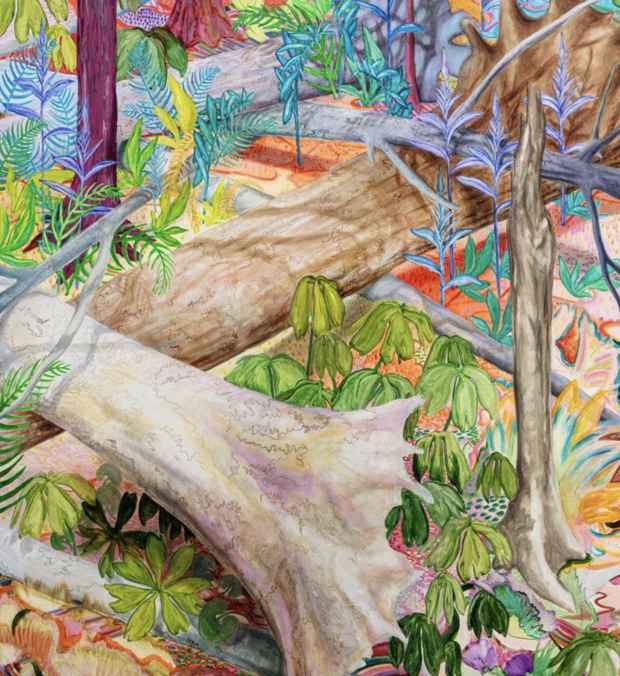Sung Hwa Kim “Today’s Yesterday, Yesterday’s Tomorrow” and Kurt Lightner “Spark”
Harper's Chelsea

[Image: Kurt Lightner "EAB 8 (large Mayapple)" (2023) acrylic on canvas, 90 x 72 in.]
This event has ended.
Harper’s presents two solo exhibitions by New York-based artists opening in New York City on January 4: Sung Hwa Kim’s Today’s Yesterday, Yesterday’s Tomorrow will be presented at Harper’s Chelsea 512; Kurt Lightner’s Spark will be on view at Harper’s Chelsea 534. Together, among new paintings, Kim and Lightner invite us into environments weathered by time and change. With these works, viewers journey through domestic scenes and the great outdoors, parsing through the histories that inform these ever-changing landscapes.
Across Spark, Lightner pays homage to the ancient woods he traversed throughout his upbringing. For Lightner, the verdant expanse bears the power of remembrance: the woods have seen perpetual annotation through the imprints of climactic evolution, social change, and familial memory. The Emerald Ash Borer beetle, for example, has left its mark on the woods. The invasive insect, which feeds on ash, decimated the once-thriving population of ash trees in the forest. The fallen trees made room for abnormal clearings: no longer shaded by a canopy of foliage, light now floods the woods. This light takes center stage in the works that comprise Spark, glimmering across effulgent palettes. Within Lightner’s landscapes, tumbling branches repeatedly descend into prisms of pastels that illuminate the forest floor. Such is the case in the works like EAB 4. Here, skeletons of trees lay bare amidst tangled cyan and yellow foliage. Hints of green matter and bright red flora are scattered throughout, as if visual reminders of new life in the wake of destruction.
Instead of recounting evolution among outdoor geographies, Sung Hwa Kim observes interior scenes as a means to trace the passage of time. In Today’s Yesterday, Yesterday’s Tomorrow, Sung Hwa Kim unravels notions of linearity within the genre of still life painting. To do so, Kim turns to the moon jar. He fills the white porcelain vessel, widely regarded as a national symbol in Korea, with divine landscapes. These jars with blooming microcosms tend to be staged near windows within traditional domestic spaces. The windows invite viewers to study vistas of their own, which deviate temporally and topographically from those within the vessels. Such is the case in Still Life with Moon Jar and Clock. Here, a luminous vase holding a lone, ashen rose is positioned in front of a window, flush with red light. Outside, a vibrant sunset dawns over a sleepy cityscape. Meanwhile, within the vessel, Kim transports us further into the night as a deep indigo moon illuminates a figure standing in a field. Ultimately, a gleaming petal, which falls from the rose that dwells in the moon jar, tethers the two divergent worlds together, reminding viewers of the interconnectivity between the dead, the living, and all that resides in between.
Kim and Lightner repeatedly collect such visual relics of transition across Today’s Yesterday, Yesterday’s Tomorrow and Spark. They capture impermanence—organic inconsistencies and irregularities—across settings prevalent in everyday life. In centering these altered ecosystems, shifting climates, and uncertain life cycles, the artists unearth the infinite adaptations that color the natural world and human existence. From their assemblage of annotations, they invite observers to reflect on the unpredictable realities that define the material world and the imperceptible sphere of cosmology. Collectively, the resultant works—brimming with luminous optimism—capture the latent potential that resides within regeneration.
Sung Hwa Kim (b. 1985, Seoul, South Korea) received a BFA from Art Institute of Boston in 2008, and an MFA from Maryland Institute College of Art in 2012. Most recently, Kim’s work has been exhibited at Harper’s, Los Angeles and East Hampton (2023 and 2021); Cob Gallery, London (2023); Everyday Gallery, Antwerp (2023); The Hole, New York (2023); Hesse Flatow, New York (2022 and 2021); Moskowitz Bayse, Los Angeles (2022); and Katonah Museum of Art, Katonah, NY (2019). His work has appeared in New American Paintings, ArtMaze Magazine, and It’s Nice That. Kim lives and works in Brooklyn.
Kurt Lightner (b. 1971, Troy, OH) received a BFA from Columbus College of Art and Design in 1993, and an MFA from School of Visual Arts in 2004. Most recently, his work has been the subject of solo presentations at Harper’s, New York (2023); Mark Moore Fine Art, online (2022); Contemporary Art Matters, Columbus (2019 and 2018); Joseph Editions, Columbus (2016); Rebecca Ibel Gallery, New York (2011); and Kemper Museum of Contemporary Art, Kansas City (2006). Lightner has participated in notable group exhibitions, including Driving Forces: Contemporary Art from the Collection of Ann and Ron Pizzuti, Columbus Museum of Art, Columbus (2019); LIC, NYC, Socrates Sculpture Park, Long Island City (2007); and Greater New York, MoMA PS1, Long Island City (2005). Reviews of his work have appeared in Artforum, Frieze, and New York Times, among other publications. Lightner currently lives and works in Queens.
Media
Schedule
from January 04, 2024 to February 17, 2024
Opening Reception on 2024-01-04 from 18:00 to 20:00